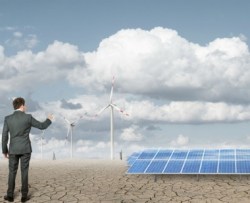
Highballs are better than lowballs.
[UPDATE: I left something very important out of this post. So when you’re done with it, read this.]
Last month, Michael Noble of Fresh Energy put up a fascinating list of projections made by energy experts around 2000 or so. (I got there via Brad Plumer.) Suffice to say, the projections did not fare well. They were badly wrong, and all in the same direction — they underestimated the growth of renewable energy. It’s worth quoting the whole list:
WIND
- In 2000, the International Energy Agency (IEA) published its World Energy Outlook, predicting that non-hydro renewable energy would comprise 3 percent of global energy by 2020. That benchmark was reached in 2008.
- In 2000, IEA projected that there would be 30 gigawatts of wind power worldwide by 2010, but the estimate was off by a factor of 7. Wind power produced 200 gigawatts in 2010, an investment of approximately $400 billion.
- In 1999, the U.S. Department of Energy estimated that total U.S. wind power capacity could reach 10 gigawatts by 2010. The country reached that amount in 2006 and quadrupled between 2006 and 2010.
- In 2000, the European Wind Energy Association predicted Europe would have 50 gigawatts of wind by 2010 and boosted that estimate to 75 two years later. Actually, 84 gigawatts of wind power were feeding into the European electric grid by 2012.
- In 2000, IEA estimated that China would have 2 gigawatts of wind power installed by 2010. China reached 45 gigawatts by the end of 2010. The IEA projected that China wind power in 2020 would be 3.7 gigawatts, but most projections now exceed 150 gigawatts, or 40 times more.
SOLAR
- In 2000, total installed global photovoltaic solar capacity was 1.5 gigawatts, and most of it was off-the-grid, like solar on NASA satellites or on cabins in the mountains or woods.
- In 2002, a top industry analyst predicted an additional 1 gigawatt annual market by 2010. The annual market in 2010 was 17 times that at 17 gigawatts.
- In 1996, the World Bank estimated 0.5 gigawatts of solar photovoltaic in China by 2020, but China reached almost double that mark — 900 megawatts — by 2010.
What should we take from this?
Well, mainly that fossil-fuel energy was really cheap in 2000. Oil was about a third the price it is now, coal for electricity about half. That colored those projections. But that’s a boring lesson. Let’s speculate about some others.
The projections weren’t just off, they were way off. You can find similarly poor projections from the ’70s that underestimate the spread of energy efficiency and other demand-side technology solutions. (They thought they were going to need hundreds of nuclear plants. See Alexis Madrigal on this.) Similarly terrible projections were also common in the early years of cell phones.
What do cell phones, energy efficiency, and renewable energy have in common? One, they are dynamic areas of technology development and market competition, which makes straight-line projections pretty useless. And two, they are distributed, with millions of loosely networked people and organizations working on them in parallel. Distributed, human-scale technologies come in small increments. They replicate quickly, so there’s more variation and competitive selection, and thus more evolution.
Nuclear power, in contrast, comes in gigantic increments only (at least for now). There’s a limited number of people doing the R&D, a limited number of entities capable of building or financing the power plants. It’s a little easier to know the potential.
When it comes to complex, parallel, loosely linked networks, the dynamics are more fluid and nonlinear changes more likely. They’re harder to quantify and predict. And so we consistently underestimate them. Something to keep in mind when pondering what today’s projections are going to look like in 2020.
Speaking of keeping things in mind, it seems to me that when projections are consistently wrong in the same direction, it bespeaks a need to update the models and techniques used to project — or at least update our expectations.
For example: Every time there’s a new air or water regulation proposed, industry predicts a level-10 economic apocalypse. EPA counters by saying it will only be a level-5 economic apocalypse. Invariably, it’s a level-0 economic apocalypse — low costs, lots of lives saved. Yet the political class approaches each new regulation with a peculiar Zen-like no-mind, as though it is the first such argument and all perspectives are equally supported by past experience. Same with projections of energy efficiency and renewables.
So why aren’t projections being updated to match what’s been observed? It’s a complicated question, but at least part of the answer is that projections are not ideologically neutral. There are assumptions and value judgments obscured behind the spreadsheets. Is efficiency a cost or an investment? What externalities are counted and for how much? To what extent is political economy taken into account? What value is placed on the welfare of our descendents (i.e., what is our “discount rate”)?
There’s no way to do projections without value judgements and assumptions, of course. But it’s good to be clear about them and, when they come into friction with experience, to be willing to rethink them. Otherwise we get stuck in a status quo sustaining feedback loop, where fossil-friendly assumptions produce fossil-friendly projections which are then used to justify fossil-friendly policies and investment decisions.
For visions of a clean energy future, brothers and sisters, look not to the soothsaying of thine “experts,” but to history, and to hope. Amen.




